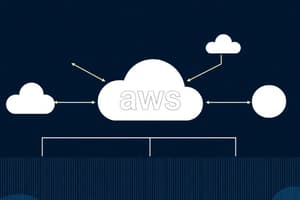Podcast
Questions and Answers
Which design principle focuses on automating tasks to minimize human error?
Which design principle focuses on automating tasks to minimize human error?
- Security
- Reliability
- Operational Excellence (correct)
- Performance Efficiency
What is a key principle of the Security pillar in the AWS Well-Architected Framework?
What is a key principle of the Security pillar in the AWS Well-Architected Framework?
- Monitor applications with Amazon CloudWatch.
- Deploy workloads across multiple AZs.
- Backup data using Amazon S3.
- Use encryption for data at rest. (correct)
In the context of Reliability, what does deploying workloads across multiple Availability Zones achieve?
In the context of Reliability, what does deploying workloads across multiple Availability Zones achieve?
- Ensures data is only stored in one location.
- Increases the cost of running applications.
- Limits the performance of the applications.
- Provides redundancy to prevent downtime. (correct)
Which AWS service is recommended for automating operational processes?
Which AWS service is recommended for automating operational processes?
What does the Performance Efficiency pillar emphasize?
What does the Performance Efficiency pillar emphasize?
Which example illustrates the principle of Reliability?
Which example illustrates the principle of Reliability?
Which tool is suggested for monitoring applications and infrastructure?
Which tool is suggested for monitoring applications and infrastructure?
What does using caching with Amazon ElastiCache primarily aim to achieve?
What does using caching with Amazon ElastiCache primarily aim to achieve?
Which of the following is a key design principle of the Security pillar?
Which of the following is a key design principle of the Security pillar?
What does AWS recommend for achieving efficient computing resource usage?
What does AWS recommend for achieving efficient computing resource usage?
What is the primary focus of the Cost Optimization pillar?
What is the primary focus of the Cost Optimization pillar?
Which of the following scenarios best illustrates the principle of Reliability?
Which of the following scenarios best illustrates the principle of Reliability?
Which of the following is a design principle under the Sustainability pillar?
Which of the following is a design principle under the Sustainability pillar?
In terms of Performance Efficiency, what is an optimal strategy for a video streaming platform?
In terms of Performance Efficiency, what is an optimal strategy for a video streaming platform?
What monitoring tool is specifically recommended for Cost Optimization?
What monitoring tool is specifically recommended for Cost Optimization?
Which AWS service can assist with process automation in accordance with Operational Excellence?
Which AWS service can assist with process automation in accordance with Operational Excellence?
How does Cost Optimization suggest handling unused infrastructure?
How does Cost Optimization suggest handling unused infrastructure?
Which principle best describes using encryption in the Security pillar?
Which principle best describes using encryption in the Security pillar?
Which scenario is an example of a key design principle of Reliability?
Which scenario is an example of a key design principle of Reliability?
Why is Auto Scaling relevant to the Sustainability pillar?
Why is Auto Scaling relevant to the Sustainability pillar?
Flashcards
AWS Well-Architected Framework
AWS Well-Architected Framework
A set of best practices to build reliable, secure, efficient, and cost-effective applications in the AWS Cloud.
Operational Excellence
Operational Excellence
Focuses on running and monitoring systems for business value and improvement.
Security Design Principle
Security Design Principle
Protecting data & systems, ensuring compliance.
Reliability Design Principle
Reliability Design Principle
Signup and view all the flashcards
Performance Efficiency
Performance Efficiency
Signup and view all the flashcards
Availability Zones (AZs)
Availability Zones (AZs)
Signup and view all the flashcards
IAM (Identity and Access Management)
IAM (Identity and Access Management)
Signup and view all the flashcards
CloudWatch
CloudWatch
Signup and view all the flashcards
Amazon S3
Amazon S3
Signup and view all the flashcards
Automated Scaling
Automated Scaling
Signup and view all the flashcards
Cost Optimization
Cost Optimization
Signup and view all the flashcards
Spot Instances
Spot Instances
Signup and view all the flashcards
AWS Cost Explorer
AWS Cost Explorer
Signup and view all the flashcards
Sustainability Principle
Sustainability Principle
Signup and view all the flashcards
Auto Scaling
Auto Scaling
Signup and view all the flashcards
Multi-AZ Deployments
Multi-AZ Deployments
Signup and view all the flashcards
Key Management Service (KMS)
Key Management Service (KMS)
Signup and view all the flashcards
CloudTrail
CloudTrail
Signup and view all the flashcards
Amazon S3 Glacier
Amazon S3 Glacier
Signup and view all the flashcards
ElastiCache
ElastiCache
Signup and view all the flashcards
Study Notes
AWS Well-Architected Framework
- The framework provides best practices and design principles for building applications in the AWS Cloud.
- It aims for reliable, secure, efficient, and cost-effective solutions.
Six Pillars of the Framework
-
Operational Excellence: Focuses on improving operations, monitoring systems, and delivering business value.
- Key principles: automate tasks, monitor applications/infrastructure (e.g., AWS CloudWatch), and refine processes.
- Example: Automatically scaling instances based on traffic patterns.
-
Security: Protecting data, systems, and assets ensuring compliance.
- Key principles: control access with IAM, encrypt data (at rest and in transit), use security tools like CloudTrail, and regularly assess vulnerabilities.
- Example: Using security groups to restrict EC2 instance access.
-
Reliability: Ensuring consistent workload functionality and recovery from failures.
- Key principles: deploy across multiple Availability Zones (AZs), use automated recovery (e.g., AWS Auto Scaling), and back up data.
- Example: Using Amazon RDS with a multi-AZ configuration.
-
Performance Efficiency: Optimizing resource use to meet demands.
- Key principles: choose appropriate instance types and services (e.g., compute-optimized instances), leverage managed services (e.g., Amazon Aurora, DynamoDB), and use caching.
- Example: Using AWS Lambda for scalable serverless applications.
-
Cost Optimization: Managing costs while delivering value.
- Key principles: use appropriate pricing models (e.g., On-Demand, Reserved Instances, Spot Instances), decommission unused resources, use cost monitoring tools (e.g., AWS Cost Explorer, AWS Budgets).
- Example: Archive infrequently accessed data in Amazon S3 Glacier.
-
Sustainability: Minimizing environmental impact.
- Key principles: use energy-efficient AWS hardware, optimize compute/storage usage, and consolidate workloads.
- Example: Auto Scaling to reduce server usage during low periods.
Key Differences and Examples
| Pillar | Focus | Examples |
|---|---|---|
| Operational Excellence | Process automation, monitoring | Automate backups, monitor logs with CloudWatch |
| Security | Data/system protection | IAM, encryption, CloudTrail |
| Reliability | Failure recovery | Multi-AZ deployments, automated recovery |
| Performance Efficiency | Resource optimization | Matching instance types, using caching |
| Cost Optimization | Cost reduction | Spot Instances, decommissioning |
| Sustainability | Environmental impact | Optimized resources, scaling down |
Real-World Scenarios
- Operational Excellence: Automating patch updates.
- Security: Encrypting customer data.
- Reliability: Deploying across multiple AZs with failover.
- Performance Efficiency: Using CloudFront for caching.
- Cost Optimization: Using Spot Instances for non-critical jobs.
- Sustainability: Auto scaling servers based on need to reduce energy.
Key Takeaways
- Each pillar focuses on a specific aspect of cloud design.
- Implementing these principles improves application reliability, security, performance, and cost-efficiency.
Studying That Suits You
Use AI to generate personalized quizzes and flashcards to suit your learning preferences.



